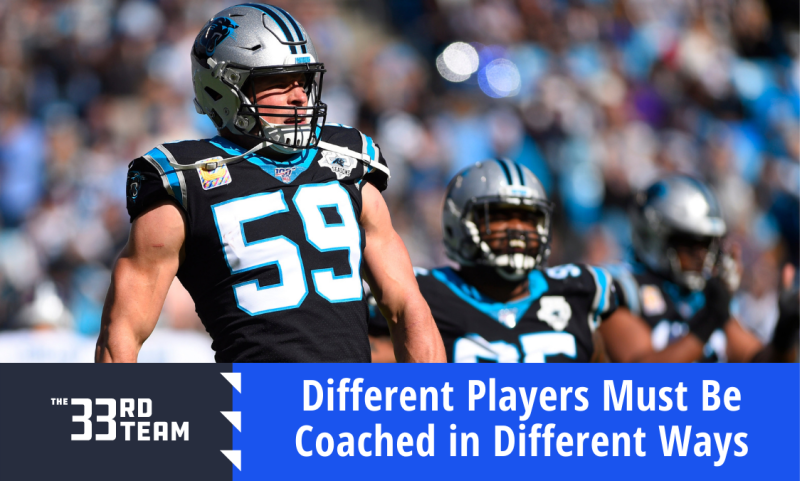Breakdowns
12/15/21
7 min read
Different Players Must be Coached In Different Ways

In partnership with Athletic Intelligence Measures, The 33rd Team features a weekly article on Sports Psychology and its effect on performance within the sport of football.
Each week, we discuss an important aspect of Sports Psychology with Dr. Goldman that can help football coaches, management, and player personnel learn what Sports Psychology really is, and learn how best to put it into practice.
In previous articles we have discussed Intelligence as a Competitive Advantage in Sports, 3 Ways NFL Teams Can Promote Mental Health, Increasing Engagement With Injured Players, and took readers Inside the Mind of an NFL Tight End.
When looking at the fundamentals of tactical or technical skill acquisition in sports, a lot of times the assumption is that every player learns the same way. As Dr. Scott Goldman tells, that assumption is not only flawed, it could be holding back players and coaches from reaching their potential and achieving their goals.
“Have you ever wondered why a player flourishes in one environment and falters in another?” Goldman says. “It isn’t the player. It isn’t the coach. Rather, it is the interaction between the player, coach, and environment that produces the output.
“Not everybody learns the same way, and not everybody executes the same way. When you have a better understanding of who a player is, you put them in positions for success on the field. Similarly, if you have a better understanding of who the person is and how they go about learning, you can teach them more efficiently.”
To help combat this issue Drs. Goldman and James Bowman created the Athletic Intelligence Quotient (AIQ), a test that identifies the strengths and weaknesses of a player’s cognitive ability.
Using empirically validated best practices, Goldman’s team of sports psychologists assesses a player’s AIQ profile and gives a tip sheet to coaches and executives that details how to get the best out of each player based on the profile, which describes how the player acquires, processes, and applies sport specific information.
“The AIQ was really meant to educate coaches on how players learn best. For example, ‘If you show a player chaotic game film he may struggle to digest all of its content, but if you dissect the film into quadrants and have the player focus on the most important details of the grid, it matches his natural learning style.’ Better understanding helps both the coach and player avoid the frustrated exchanges that are inevitable when the flow of training is disrupted,” Goldman says.
“I’ve never met a coach that says, ‘Man, I really love yelling obscenities at players.’ And likewise I’ve never met a player who says, ‘Gosh, I just love having obscenities yelled at me.’”
Fundamentally, coaches want to teach, players want to learn, and they both want to have success. So why does the kind of intense interaction referenced above occur so often in sport?
“I think it’s mostly due to frustration,” Goldman says. “The Coach is trying to teach something to the player, the player is trying to learn something from the coach. And when there’s a disconnect, frustration ensues and there becomes a relationship dynamic that can sometimes be jeopardized by intense exchanges.
“Looking at it from an engineering standpoint, it’s as if the coach flips on the light switch, but the player’s light doesn't turn on. Instead of getting upset at the light, the AIQ helps to look at the circuitry and see where the current is lost. The coaching tips repair that, so that when the coach flips that switch next time, the light will turn on.”
One example of how two players at the same position should be coached differently based on their AIQ profile comes at the off-ball linebacker position, where a keen intellect can be just as important as elite physical attributes.
“Let’s say you have a middle linebacker, Player A, who has high learning efficiency, the ability to download and recall information, succeeds by recognizing the pre-snap formation and recalls what is coming next from what they learned during the installs and film study,” Goldman says. “By contrast, there can also be another middle linebacker, Player B, who may not excel with learning efficiency, but scores highly on visual spatial processing — the ability to see the flow of the game in live time.
“Player B might not necessarily recognize the play that’s being called in the way that Player A would, but what they’re doing is responding to what’s happening. The guard pulls… The A-gap opens up... The running back bursts through the seam… Player B, with his high visual spatial processing score sees what is happening, identifies it, finds an efficient pursuit angle and gets to the ball carrier successfully.
“When it comes to Player A, who has a higher learning efficiency, it’s all about coaching them up. That way, he’s like your iPhone’s music library where you just hit play on a song and he executes exactly as coached.
“Meanwhile, Player B, who has a higher visual spatial processing score, is almost like improvised jazz in a theater. You’ve got to let that player go and feel the game and trust that he’ll make good plays. One might call this instinct and suggest that instinct can’t be measured, but really it’s intellect, which can be measured. It’s measured by the AIQ.”
While it may be easy to compare Player A and Player B directly and adjust how you coach each of them, with as many as 90 players on an NFL offseason roster, it can be difficult for coaches to remember how they should be treating each specific player.
“When I’m having this dialogue with coaches, they often say, ‘I’ve got a 53 man roster. It’s not like I can teach 53 people in 53 ways,’” Goldman says. “I agree with that. Sometimes it’s about looking for commonality in a teaching mechanism. Sometimes certain players have a more vital role in the system than others and the focus should be on them.
“Another part of it is trying to find goodness of fit. As Herb Brooks once famously said, ‘I don’t want the best players, I want the right players.’
“So if you’ve got a coach who is really committed to a particular style, both in style of play and in style of teaching, you might want to make sure that you’re finding players that respond well to his teaching style and game planning.”
Many of the NFL’s coaches are among the best teachers in the world. Those coaches figure out their players eventually and adjust their approach to fit the player’s mental abilities as they learn, but with coaching tips from the AIQ, teams have the answers to the test before the player even sets foot in the facility.
“It’s really about speeding up the learning curve between the coach and player. That way frustration decreases and performance efficiency increases,” Goldman says.
“Every time there’s a new CBA, the players ask for less time in the building and the teams and coaches want more time in the building. If you understand how your players acquire, process and apply information, you can create a space where the coaches are more efficient and don’t need as much time. As a result, the players are happy and the coaches are happy. It becomes a win-win situation.”
You can find more information about Scott Goldman’s company Athletic Intelligence Measures here. To get in contact with Scott, please email him at info@athleticintel.com








